Using Low-Cost Measurement Systems to Investigate Air Quality: A Case Study in Palapye, Botswana
Abstract
1. Introduction
2. Methods
2.1. Site Description and Important Aerosol Sources
2.2. Measurements
2.3. Ancillary and Remote Observations, and Back-Trajectory Modelling
3. Results and Discussion
3.1. Concentrations at BIUST
3.2. Filter PM2.5 Composition Characterization
3.3. Temporal Variability
4. Conclusions
Author Contributions
Funding
Acknowledgments
Conflicts of Interest
References
- Dockery, D.W.; Pope, C.A.; Xu, X.; Spengler, J.D.; Ware, J.H.; Fay, M.E.; Ferris, B.G., Jr.; Speizer, F.E. An association between air pollution and mortality in six U.S. Cities. N. Engl. J. Med. 1993, 329, 1753–1759. [Google Scholar] [CrossRef] [PubMed]
- Pope, C.A. Epidemiology of fine particulate air pollution and human health: Biologic mechanisms and who’s at risk? Environ. Health Perspect 2000, 108, 713–723. [Google Scholar] [CrossRef] [PubMed]
- Forouzanfar, M.H.; Alexander, L.; Anderson, H.R.; Bachman, V.F.; Biryukov, S.; Brauer, M.; Burnett, R.; Casey, D.; Coates, M.M.; Cohen, A.; et al. Global, regional, and national comparative risk assessment of 79 behavioural, environmental and occupational, and metabolic risks or clusters of risks in 188 countries, 1990–2013: A systematic analysis for the global burden of disease study 2013. Lancet 2015, 386, 2287–2323. [Google Scholar] [CrossRef]
- Brauer, M.; Amann, M.; Burnett, R.T.; Cohen, A.; Dentener, F.; Ezzati, M.; Henderson, S.B.; Krzyzanowski, M.; Martin, R.V.; Van Dingenen, R.; et al. Exposure assessment for estimation of the global burden of disease attributable to outdoor air pollution. Environ. Sci. Technol. 2012, 46, 652–660. [Google Scholar] [CrossRef] [PubMed]
- van Donkelaar, A.; Martin, R.V.; Levy, R.C.; da Silva, A.M.; Krzyzanowski, M.; Chubarova, N.E.; Semutnikova, E.; Cohen, A.J. Satellite-based estimates of ground-level fine particulate matter during extreme events: A case study of the Moscow fires in 2010. Atmos. Environ. 2011, 45, 6225–6232. [Google Scholar] [CrossRef]
- Ford, B.; Heald, C.L. Exploring the uncertainty associated with satellite-based estimates of premature mortality due to exposure to fine particulate matter. Atmos. Chem. Phys. 2016, 16, 3499–3523. [Google Scholar] [CrossRef]
- Kodros, J.K.; Carter, E.; Brauer, M.; Volckens, J.; Bilsback, K.R.; L’Orange, C.; Johnson, M.; Pierce, J.R. Quantifying the contribution to uncertainty in mortality attributed to household, ambient, and joint exposure to PM2.5 from residential solid fuel use. GeoHealth 2018, 2, 25–39. [Google Scholar] [CrossRef]
- Bonjour, S.; Adair-Rohani, H.; Wolf, J.; Bruce, N.G.; Mehta, S.; Prüss-Ustün, A.; Lahiff, M.; Rehfuess, E.A.; Mishra, V.; Smith, K.R. Solid fuel use for household cooking: Country and regional estimates for 1980–2010. Environ. Health Perspect 2013, 121, 784–790. [Google Scholar] [CrossRef]
- Bond, T.C.; Streets, D.G.; Yarber, K.F.; Nelson, S.M.; Woo, J.-H.; Klimont, Z. A technology-based global inventory of black and organic carbon emissions from combustion. J. Geophys. Res. Atmos. 2004, 109. [Google Scholar] [CrossRef]
- Coffey, E.R.; Muvandimwe, D.; Hagar, Y.; Wiedinmyer, C.; Kanyomse, E.; Piedrahita, R.; Dickinson, K.L.; Oduro, A.; Hannigan, M.P. New emission factors and efficiencies from in-field measurements of traditional and improved cookstoves and their potential implications. Environ. Sci. Technol. 2017, 51, 12508–12517. [Google Scholar] [CrossRef]
- Marais, E.A.; Silvern, R.F.; Vodonos, A.; Dupin, E.; Bockarie, A.S.; Mickley, L.J.; Schwartz, J. Air quality and health impact of future fossil fuel use for electricity generation and transport in Africa. Environ. Sci. Technol. 2019, 53, 13524–13534. [Google Scholar] [CrossRef] [PubMed]
- Transport and Infrastructure Report 2017. Available online: http://www.statsbots.org.bw/transport-and-infrastructure-report-2017 (accessed on 7 November 2019).
- Kelly, M.S.; Wirth, K.E.; Madrigano, J.; Feemster, K.A.; Cunningham, C.K.; Arscott-Mills, T.; Boiditswe, S.; Shah, S.S.; Finalle, R.; Steenhoff, A.P. The effect of exposure to wood smoke on outcomes of childhood pneumonia in Botswana. Int. J. Tuberc. Lung Dis. 2015, 19, 349–355. [Google Scholar] [CrossRef] [PubMed]
- Kumar, P.; Morawska, L.; Martani, C.; Biskos, G.; Neophytou, M.; Di Sabatino, S.; Bell, M.; Norford, L.; Britter, R. The rise of low-cost sensing for managing air pollution in cities. Environ. Int. 2015, 75, 199–205. [Google Scholar] [CrossRef] [PubMed]
- Clements, A.L.; Griswold, W.G.; Rs, A.; Johnston, J.E.; Herting, M.M.; Thorson, J.; Collier-Oxandale, A.; Hannigan, M. Low-cost air quality monitoring tools: From research to practice (a workshop summary). Sensors 2017, 17, 2478. [Google Scholar] [CrossRef] [PubMed]
- Rai, A.C.; Kumar, P.; Pilla, F.; Skouloudis, A.N.; Di Sabatino, S.; Ratti, C.; Yasar, A.; Rickerby, D. End-user perspective of low-cost sensors for outdoor air pollution monitoring. Sci. Total Environ. 2017, 607–608, 691–705. [Google Scholar] [CrossRef]
- Ford, B.; Pierce, J.R.; Wendt, E.; Long, M.; Jathar, S.; Mehaffy, J.; Tryner, J.; Quinn, C.; van Zyl, L.; L’Orange, C.; et al. A low-cost monitor for measurement of fine particulate matter and aerosol optical depth—Part 2: Citizen science pilot campaign in northern Colorado. Atmos. Meas. Tech. Discuss. 2019, 1–20. [Google Scholar] [CrossRef]
- Wendt, E.A.; Quinn, C.W.; Miller-Lionberg, D.D.; Tryner, J.; L’Orange, C.; Ford, B.; Yalin, A.P.; Pierce, J.R.; Jathar, S.; Volckens, J. A low-cost monitor for simultaneous measurement of fine particulate matter and aerosol optical depth—Part 1: Specifications and testing. Atmos. Meas. Tech. 2019, 12, 5431–5441. [Google Scholar] [CrossRef]
- Cold Front Expected to Hit Parts of SA. Available online: http://www.sabcnews.com/sabcnews/cold-front-expected-to-hit-parts-of-sa/ (accessed on 20 November 2019).
- Wiston, M. Status of air pollution in Botswana and significance to air quality and human health. J. Health Pollut. 2017, 7, 8–17. [Google Scholar] [CrossRef]
- Eilerman, S.J.; Peischl, J.; Neuman, J.A.; Ryerson, T.B.; Aikin, K.C.; Holloway, M.W.; Zondlo, M.A.; Golston, L.M.; Pan, D.; Floerchinger, C.; et al. Characterization of ammonia, methane, and nitrous oxide emissions from concentrated animal feeding operations in northeastern Colorado. Environ. Sci. Technol. 2016, 50, 10885–10893. [Google Scholar] [CrossRef]
- Shonkwiler, K.; Ham, J. Ammonia emissions from a beef feedlot: Comparison of inverse modeling techniques using long-path and point measurements of fenceline NH3. Agric. For. Meteorol. 2018, 258, 29–42. [Google Scholar] [CrossRef]
- Yang, Y.; Liao, W.; Wang, X.; Liu, C.; Xie, Q.; Gao, Z.; Ma, W.; He, Y. Quantification of ammonia emissions from dairy and beef feedlots in the Jing-Jin-Ji district, China. Agric. Ecosyst. Environ. 2016, 232, 29–37. [Google Scholar] [CrossRef]
- Jayaratne, E.R.; Verma, T.S. The impact of biomass burning on the environmental aerosol concentration in Gaborone, Botswana. Atmos. Environ. 2001, 35, 1821–1828. [Google Scholar] [CrossRef]
- Marais, E.A.; Wiedinmyer, C. Air quality impact of diffuse and inefficient combustion emissions in Africa (DICE-Africa). Environ. Sci. Technol. 2016, 50, 10739–10745. [Google Scholar] [CrossRef] [PubMed]
- Lonsdale, C.R.; Stevens, R.G.; Brock, C.A.; Makar, P.A.; Knipping, E.M.; Pierce, J.R. The effect of coal-fired power-plant SO2 and NOx control technologies on aerosol nucleation in the source plumes. Atmos. Chem. Phys. 2012, 12, 11519–11531. [Google Scholar] [CrossRef]
- Nelson, P.F.; Tibbett, A.R.; Day, S.J. Effects of vehicle type and fuel quality on real world toxic emissions from diesel vehicles. Atmos. Environ. 2008, 42, 5291–5303. [Google Scholar] [CrossRef]
- Volckens, J.; Quinn, C.; Leith, D.; Mehaffy, J.; Henry, C.S.; Miller-Lionberg, D. Development and evaluation of an ultrasonic personal aerosol sampler. Indoor Air 2017, 27, 409–416. [Google Scholar] [CrossRef]
- Kelly, K.E.; Whitaker, J.; Petty, A.; Widmer, C.; Dybwad, A.; Sleeth, D.; Martin, R.; Butterfield, A. Ambient and laboratory evaluation of a low-cost particulate matter sensor. Environ. Pollut. 2017, 221, 491–500. [Google Scholar] [CrossRef]
- Yong, Z. Digital Universal Particle Concentration Sensor PMS5003 Series Data Manual. Available online: http://www.aqmd.gov/docs/default-source/aq-spec/resources-page/plantower-pms1003-manual_v2-5.pdf?sfvrsn=2 (accessed on 19 May 2020).
- Bulot, F.M.J.; Johnston, S.J.; Basford, P.J.; Easton, N.H.C.; Apetroaie-Cristea, M.; Foster, G.L.; Morris, A.K.R.; Cox, S.J.; Loxham, M. Long-term field comparison of multiple low-cost particulate matter sensors in an outdoor urban environment. Sci. Rep. 2019, 9, 1–13. [Google Scholar] [CrossRef]
- Sayahi, T.; Butterfield, A.; Kelly, K.E. Long-term field evaluation of the Plantower PMS low-cost particulate matter sensors. Environ. Pollut. 2019, 245, 932–940. [Google Scholar] [CrossRef]
- Jimenez, J.L.; Canagaratna, M.R.; Donahue, N.M.; Prevot, A.S.H.; Zhang, Q.; Kroll, J.H.; DeCarlo, P.F.; Allan, J.D.; Coe, H.; Ng, N.L.; et al. Evolution of organic aerosols in the atmosphere. Science 2009, 326, 1525–1529. [Google Scholar] [CrossRef]
- Magi, B.I.; Ginoux, P.; Ming, Y.; Ramaswamy, V. Evaluation of tropical and extratropical Southern Hemisphere African aerosol properties simulated by a climate model. J. Geophys. Res. Atmos. 2009, 114. [Google Scholar] [CrossRef]
- Tesfaye, M.; Sivakumar, V.; Botai, J.; Tsidu, G.M.; Rautenbach, C.J. deW Simulation of anthropogenic aerosols mass distributions and analysing their direct and semi-direct effects over South Africa using RegCM4. Int. J. Climatol. 2015, 35, 3515–3539. [Google Scholar] [CrossRef]
- Tesfaye, M.; Botai, J.; Sivakumar, V.; Mengistu Tsidu, G. Evaluation of Regional Climatic Model Simulated Aerosol Optical Properties over South Africa Using Ground-Based and Satellite Observations. Available online: https://www.hindawi.com/journals/isrn/2013/237483/ (accessed on 11 May 2020).
- Hering, S.; Cass, G. The magnitude of bias in the measurement of PM25 arising from volatilization of particulate nitrate from Teflon filters. J. Air Waste Manag. Assoc. 1999, 49, 725–733. [Google Scholar] [CrossRef] [PubMed]
- Wexler, A.S.; Clegg, S.L. Atmospheric aerosol models for systems including the ions H+, NH4+, Na+, SO42−, NO3−, Cl−, Br−, and H2O. J. Geophys. Res. Atmos. 2002, 107, ACH 14-1–ACH 14-14. [Google Scholar] [CrossRef]
- Rennie, T.; Light, D.; Rutherford, A.; Miller, M.; Fisher, I.; Pratchett, D.; Capper, B.; Buck, N.; Trail, J. Beef cattle productivity under traditional and improved management in Botswana. Trop. Anim. Health Prod. 1977, 9, 1–6. [Google Scholar] [CrossRef]
- Shen, J.; Chen, D.; Bai, M.; Sun, J.; Coates, T.; Lam, S.K.; Li, Y. Ammonia deposition in the neighbourhood of an intensive cattle feedlot in Victoria, Australia. Sci. Rep. 2016, 6, 32793. [Google Scholar] [CrossRef]
- Hristov, A.N.; Hanigan, M.; Cole, A.; Todd, R.; McAllister, T.A.; Ndegwa, P.M.; Rotz, A. Review: Ammonia emissions from dairy farms and beef feedlots. Can. J. Anim. Sci. 2011, 91, 1–35. [Google Scholar] [CrossRef]
- McGinn, S.M.; Janzen, H.H.; Coates, T.W.; Beauchemin, K.A.; Flesch, T.K. Ammonia emission from a beef cattle feedlot and its local dry deposition and re-emission. J. Environ. Qual. 2016, 45, 1178–1185. [Google Scholar] [CrossRef]
- Sutton, M.A.; Milford, C.; Dragosits, U.; Place, C.J.; Singles, R.J.; Smith, R.I.; Pitcairn, C.E.R.; Fowler, D.; Hill, J.; ApSimon, H.M.; et al. Dispersion, deposition and impacts of atmospheric ammonia: Quantifying local budgets and spatial variability. Environ. Pollut. 1998, 102, 349–361. [Google Scholar] [CrossRef]
- Webb, J.; Menzi, H.; Pain, B.F.; Misselbrook, T.H.; Dämmgen, U.; Hendriks, H.; Döhler, H. Managing ammonia emissions from livestock production in Europe. Environ. Pollut. 2005, 135, 399–406. [Google Scholar] [CrossRef]
- Tesfaye, M.; Tsidu, G.M.; Botai, J.; Sivakumar, V.; Rautenbach, C.D. Mineral dust aerosol distributions, its direct and semi-direct effects over South Africa based on regional climate model simulation. J. Arid Environ. 2015, 114, 22–40. [Google Scholar] [CrossRef]
- McDonald, B.C.; de Gouw, J.A.; Gilman, J.B.; Jathar, S.H.; Akherati, A.; Cappa, C.D.; Jimenez, J.L.; Lee-Taylor, J.; Hayes, P.L.; McKeen, S.A.; et al. Volatile chemical products emerging as largest petrochemical source of urban organic emissions. Science 2018, 359, 760–764. [Google Scholar] [CrossRef] [PubMed]
- Lassman, W.; Ford, B.; Gan, R.W.; Pfister, G.; Magzamen, S.; Fischer, E.V.; Pierce, J.R. Spatial and temporal estimates of population exposure to wildfire smoke during the Washington state 2012 wildfire season using blended model, satellite, and in situ data. GeoHealth 2017, 1, 106–121. [Google Scholar] [CrossRef] [PubMed]
- Lassman, W.; Pierce, J.R.; Bangs, E.J.; Sullivan, A.P.; Ford, B.; Mengistu Tsidu, G.; Sherman, J.P.; Collett, J.L., Jr.; Bililign, S. Using Low-Cost Measurement Systems to Investigate Air Quality: A Case Study in Palapye, Botswana: Data Repository 2020. Available online: https://mountainscholar.org/bitstream/handle/10217/207600/Lassman_et_al_202006_10217-207600.zip?sequence=3 (accessed on 19 May 2020).
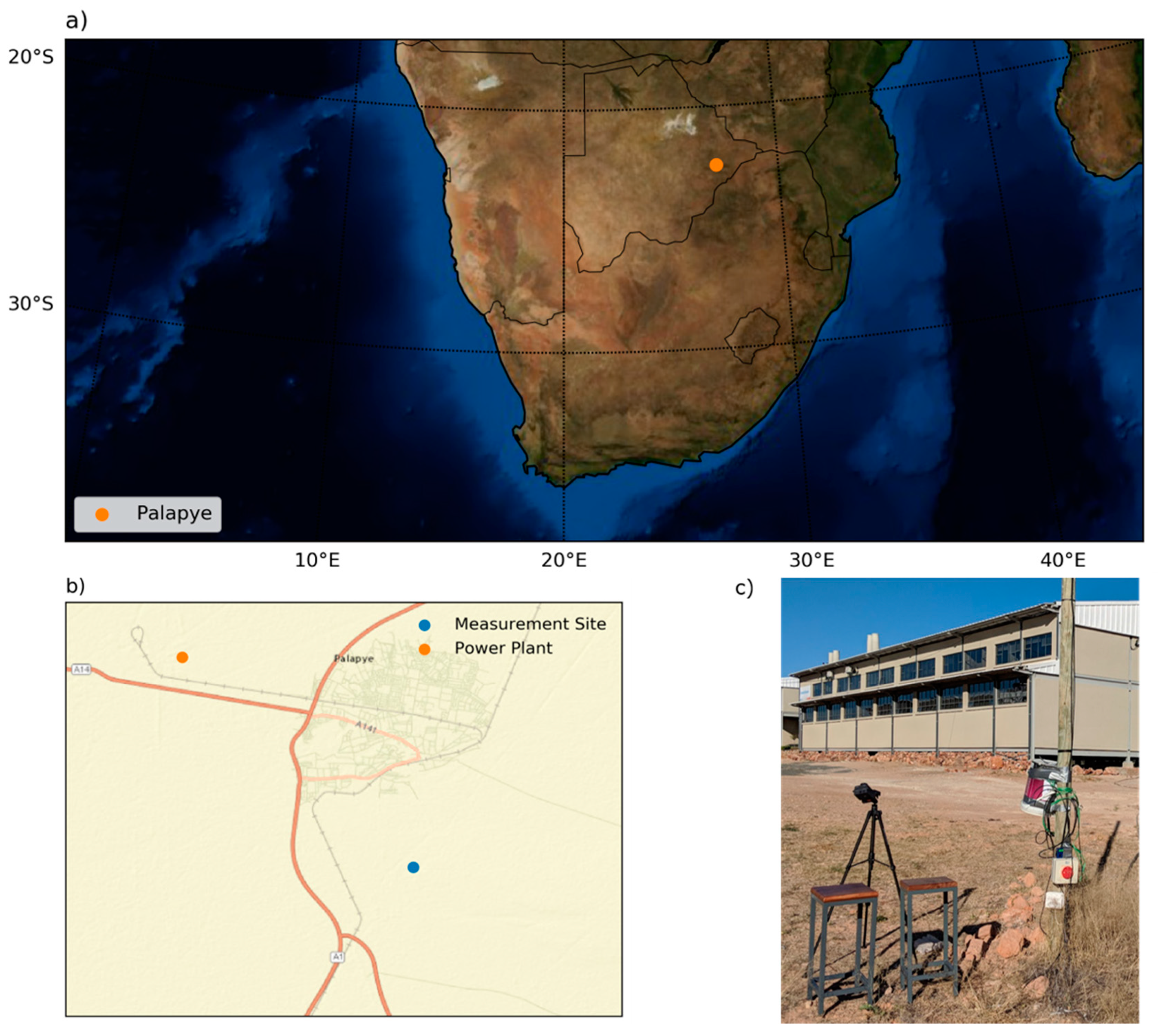
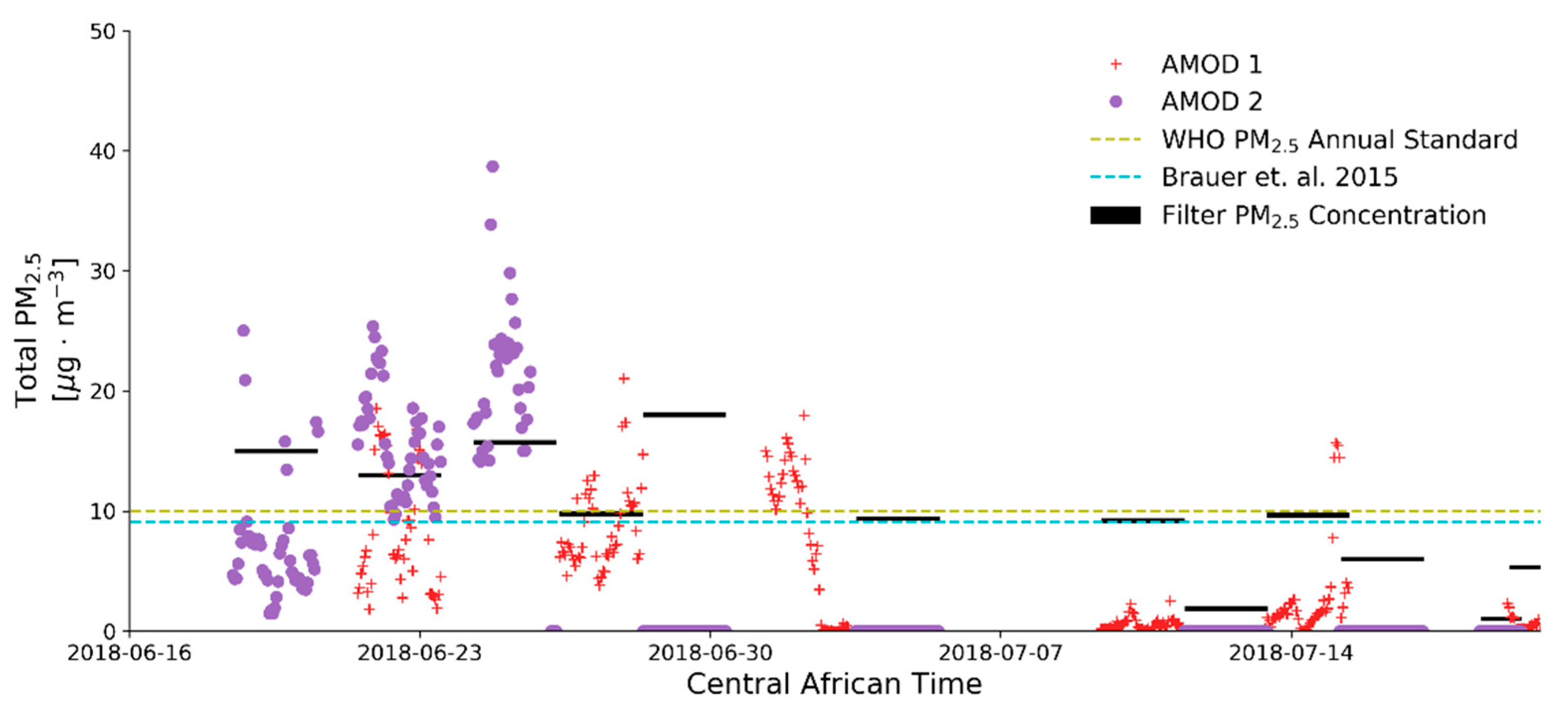
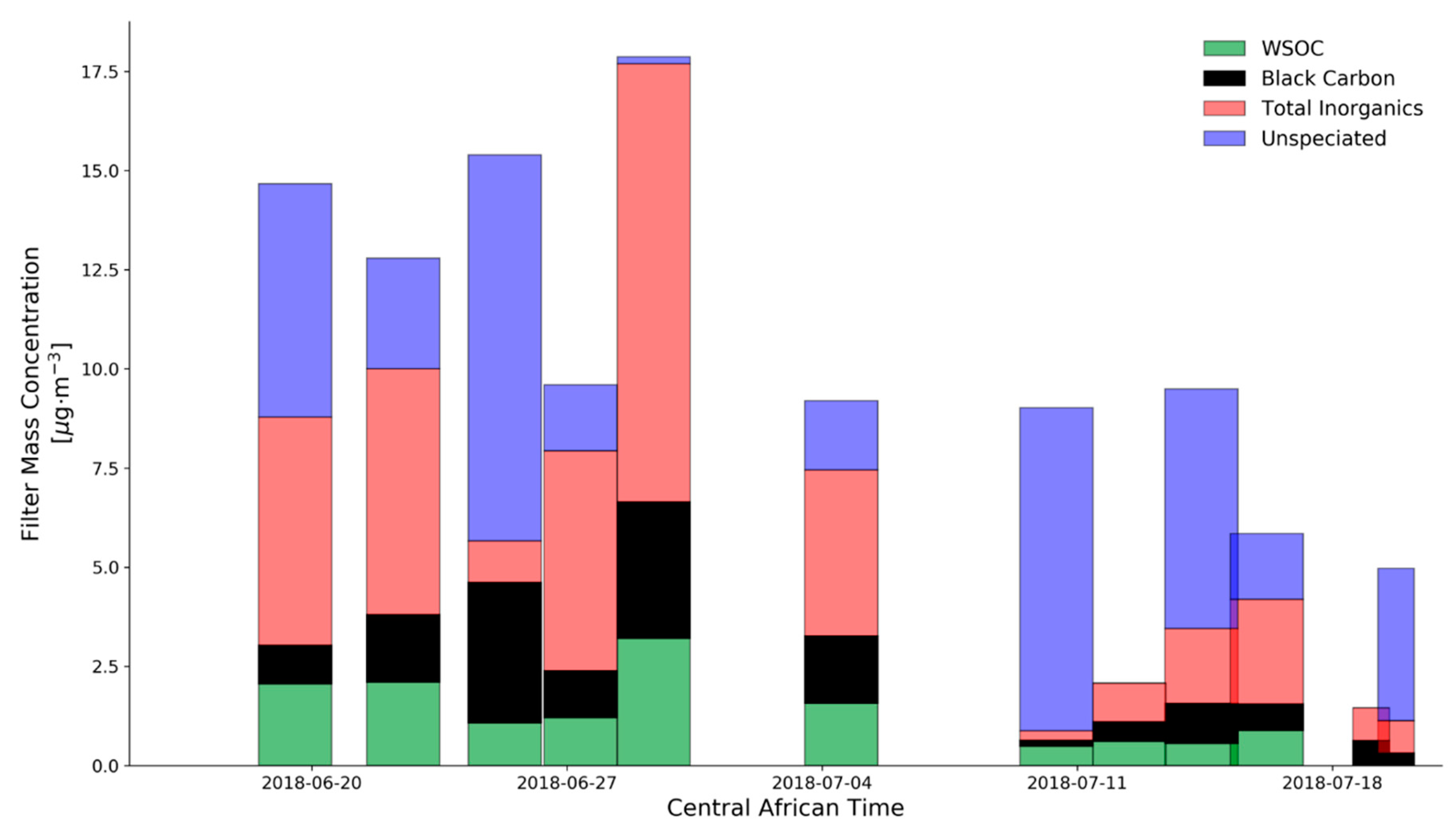
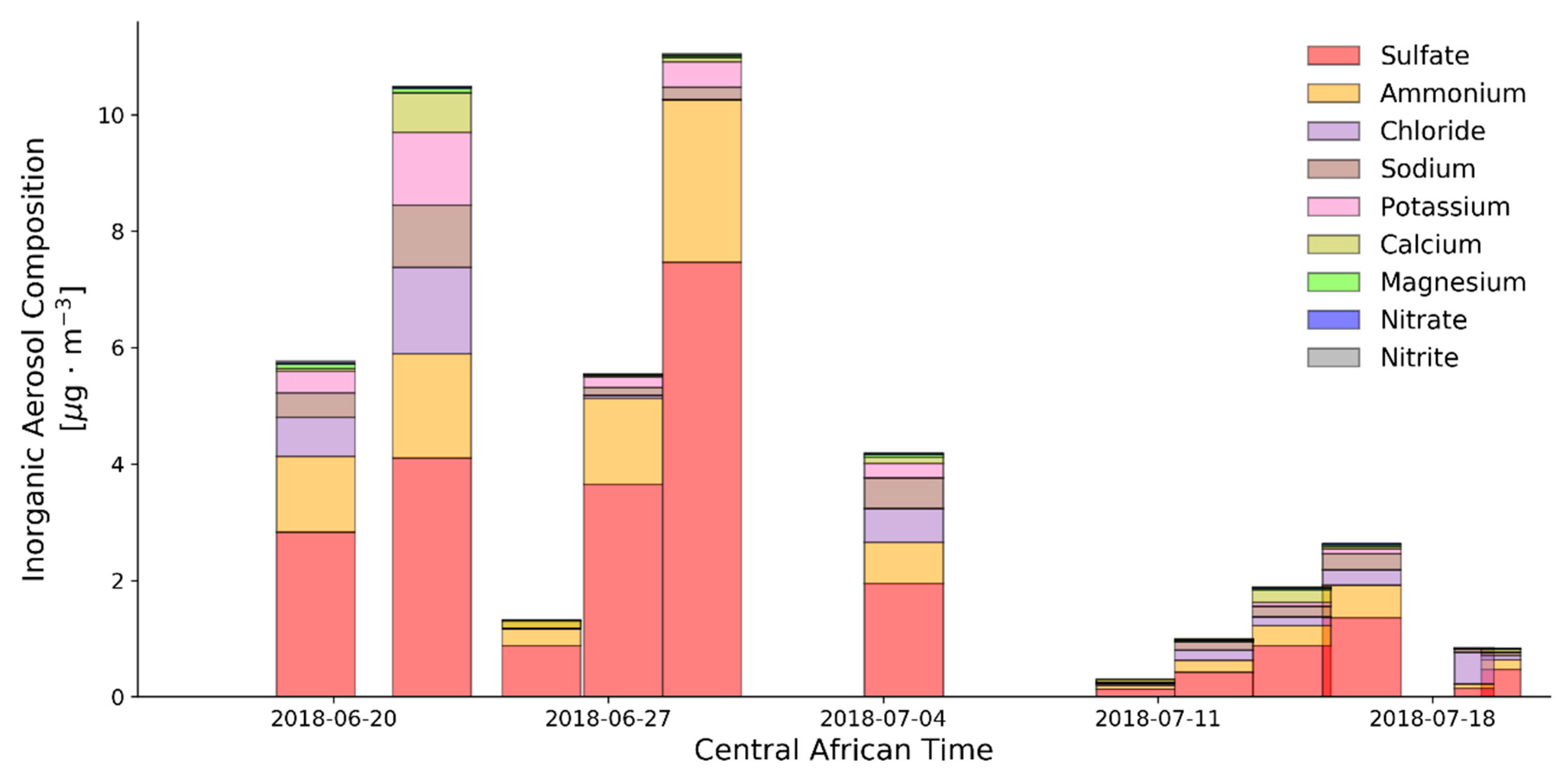
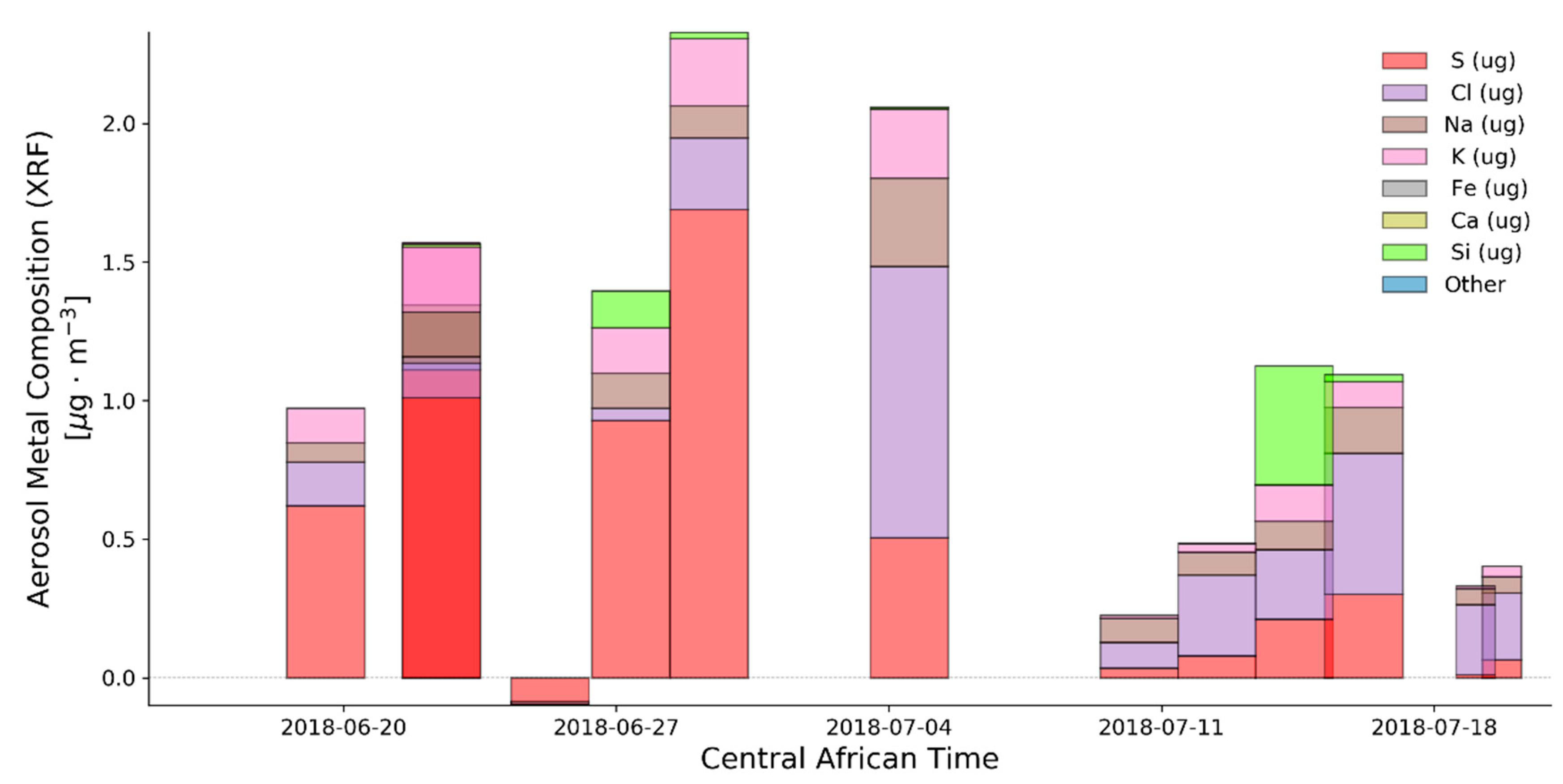
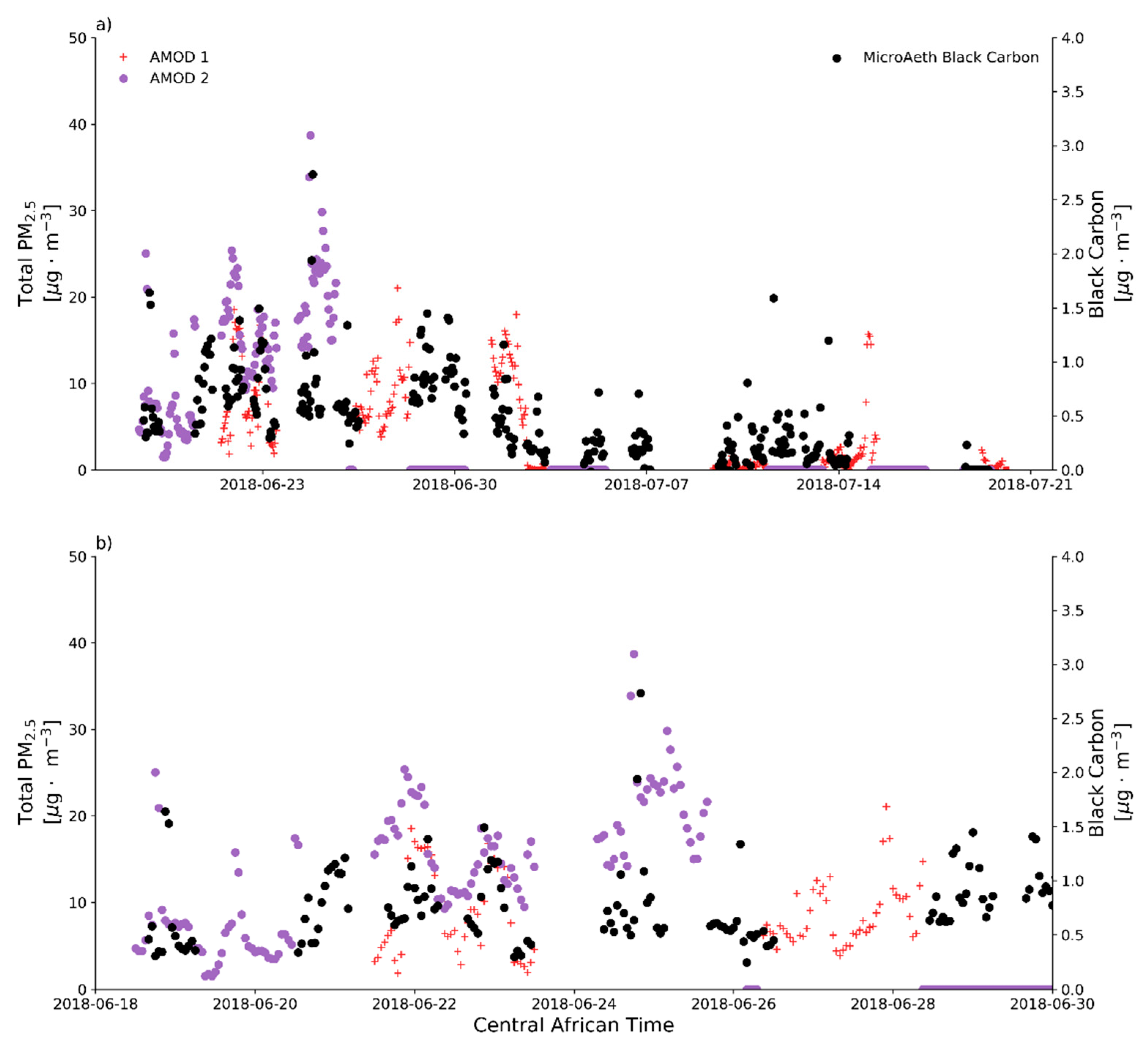
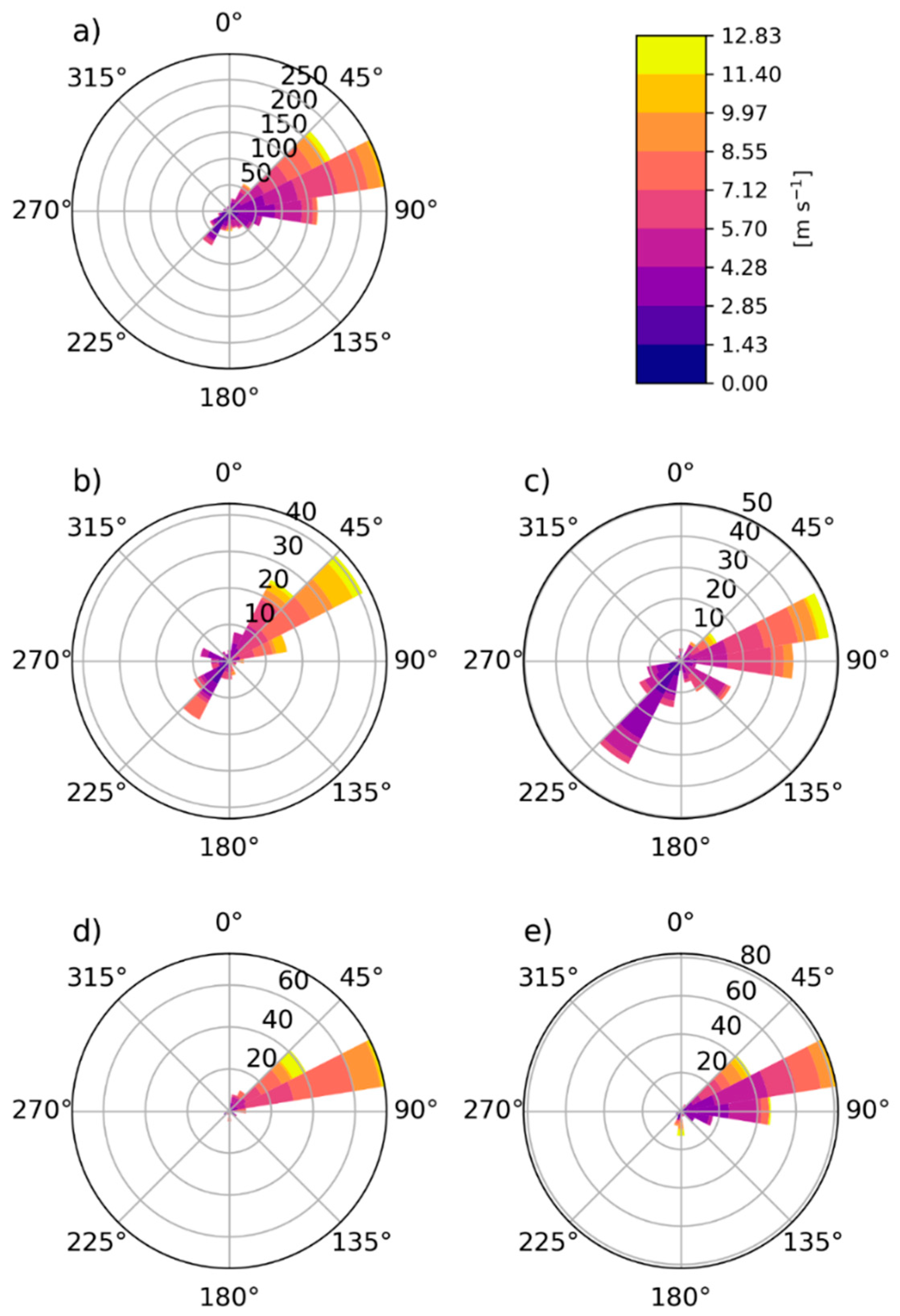
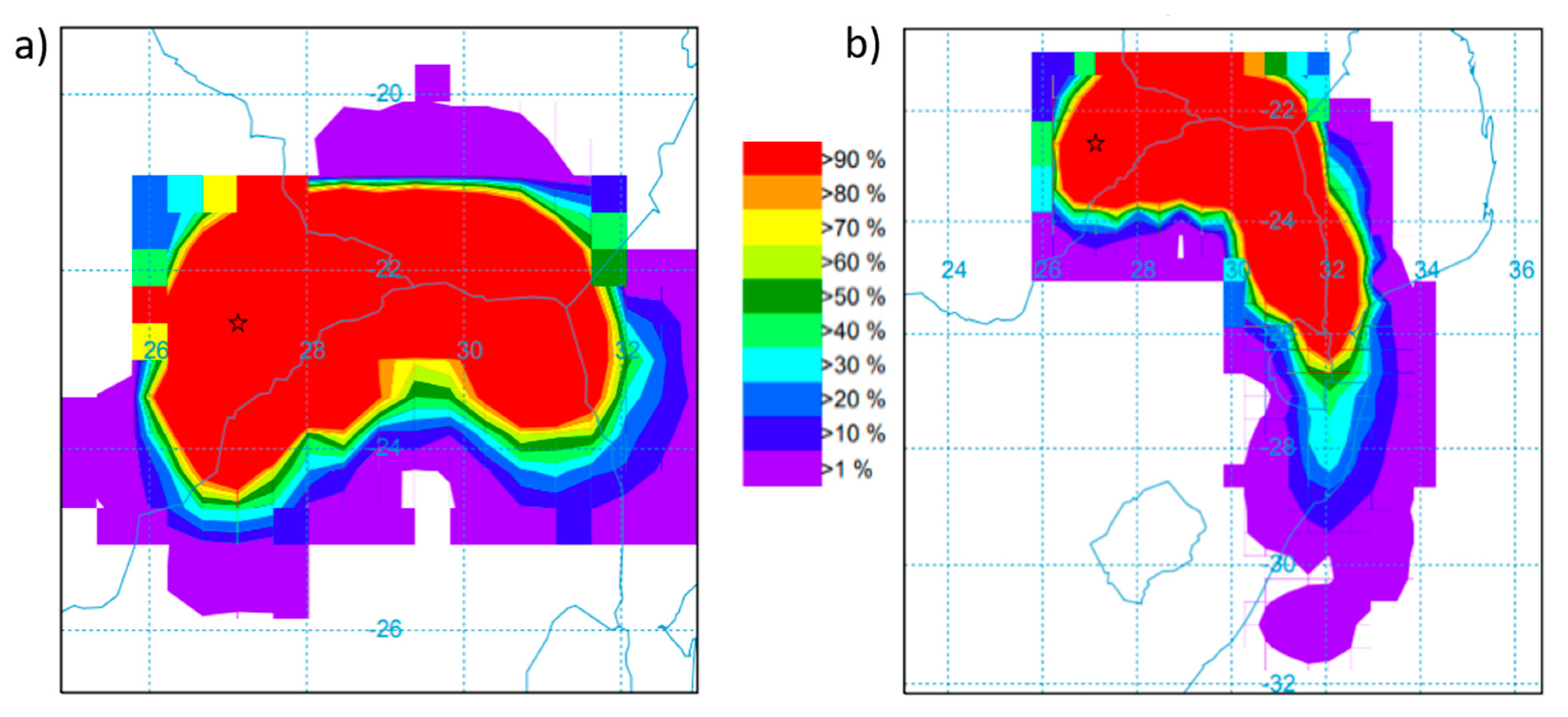
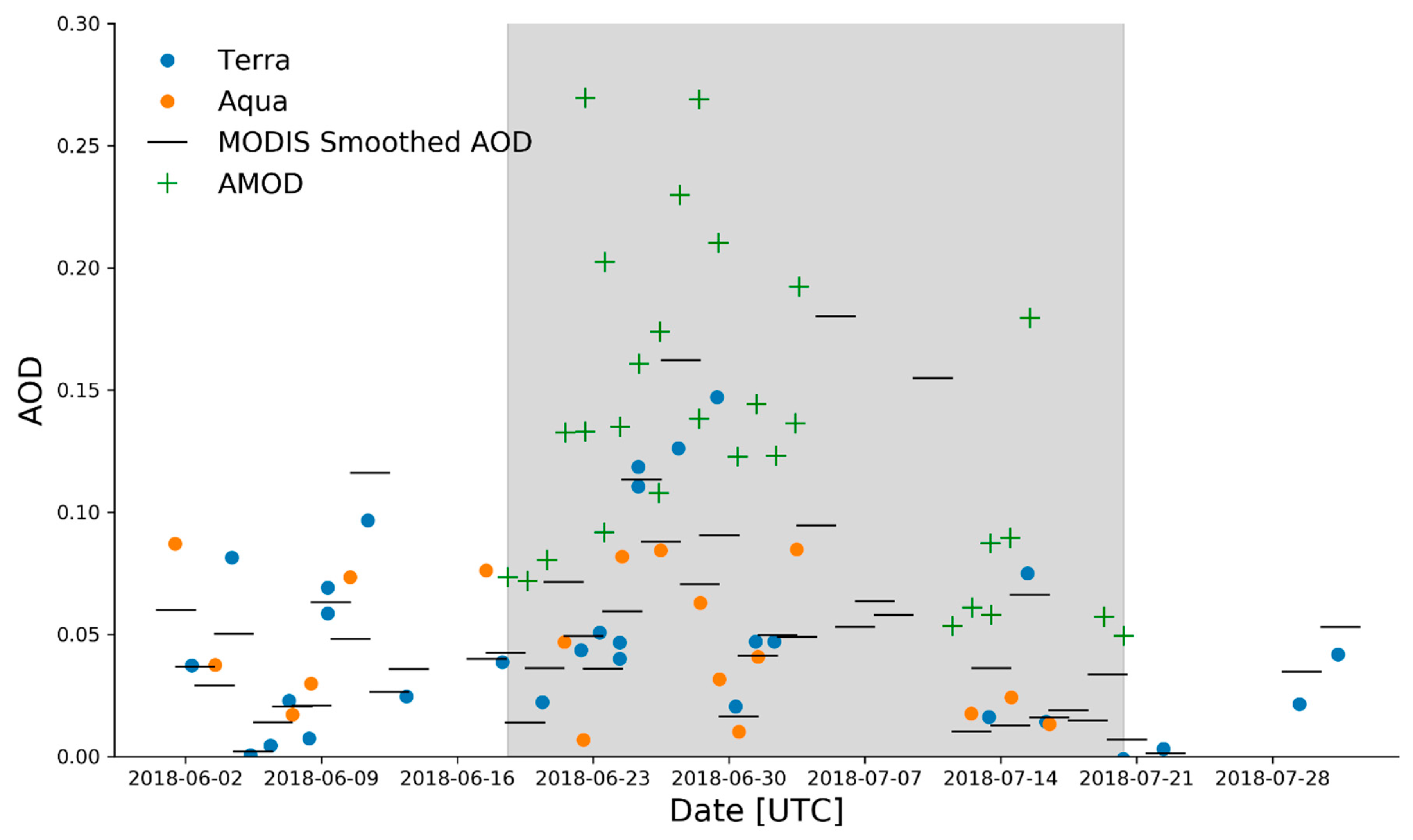
© 2020 by the authors. Licensee MDPI, Basel, Switzerland. This article is an open access article distributed under the terms and conditions of the Creative Commons Attribution (CC BY) license (http://creativecommons.org/licenses/by/4.0/).
Share and Cite
Lassman, W.; Pierce, J.R.; Bangs, E.J.; Sullivan, A.P.; Ford, B.; Mengistu Tsidu, G.; Sherman, J.P.; Collett, J.L., Jr.; Bililign, S. Using Low-Cost Measurement Systems to Investigate Air Quality: A Case Study in Palapye, Botswana. Atmosphere 2020, 11, 583. https://doi.org/10.3390/atmos11060583
Lassman W, Pierce JR, Bangs EJ, Sullivan AP, Ford B, Mengistu Tsidu G, Sherman JP, Collett JL Jr., Bililign S. Using Low-Cost Measurement Systems to Investigate Air Quality: A Case Study in Palapye, Botswana. Atmosphere. 2020; 11(6):583. https://doi.org/10.3390/atmos11060583
Chicago/Turabian StyleLassman, William, Jeffrey R. Pierce, Evelyn J. Bangs, Amy P. Sullivan, Bonne Ford, Gizaw Mengistu Tsidu, James P. Sherman, Jeffrey L. Collett, Jr., and Solomon Bililign. 2020. "Using Low-Cost Measurement Systems to Investigate Air Quality: A Case Study in Palapye, Botswana" Atmosphere 11, no. 6: 583. https://doi.org/10.3390/atmos11060583
APA StyleLassman, W., Pierce, J. R., Bangs, E. J., Sullivan, A. P., Ford, B., Mengistu Tsidu, G., Sherman, J. P., Collett, J. L., Jr., & Bililign, S. (2020). Using Low-Cost Measurement Systems to Investigate Air Quality: A Case Study in Palapye, Botswana. Atmosphere, 11(6), 583. https://doi.org/10.3390/atmos11060583





